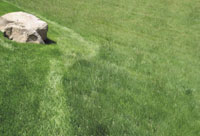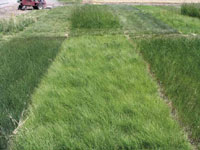



Source: www.TurfMagazine.com
Native grass sod promises less watering, mowing, pest problems
At first glance, the fields at BioGrass Sod Farms in Sandy, Utah, look pretty much like any other sod farm, but the company has put a lot of scientific work into ensuring the grasses growing there are a bit out of the ordinary. Alongside more traditional turf varieties, the company is growing a number of native grass sods, bringing the low water-use and other beneficial characteristics these grasses can provide into the turfgrass world.
|
Warren Bell, owner of BioGrass Sod Farms, says the company was started in 1979. “At that time, we didn’t have any idea of water-use characteristics of grasses, or the scrutiny that would be put on them over that issue,” he says. By the mid-1980s, however, concerns started to be voiced about the water used to irrigate turfgrasses, especially in the arid Salt Lake City environment. “We’re reasonably close to Denver, where the term ‘xeriscape’ was first started,” Bell adds. It didn’t take long for the company to realize that debates over turfgrass water use were not a trend.
In the late 1980s, the company entered into a partnership to grow wildflower sod, and Bell’s studies at Utah State University made him more aware of sustainable, low-water-use landscapes. “Back in those days, the solution in everyone’s mind seemed to be, ‘Well, just don’t plant any grass,’” says Bell. For these advocates, the simple solution was to replace grass with gravel in the landscape.
Bell had other ideas, though, and by the early 1990s, BioGrass began to experiment with low-water-use grasses. “We started to look at varieties beyond the common Kentucky bluegrasses,” he says. “We realized there are so many different types of Kentucky bluegrasses, and we began to be aware of all the different characteristics found within that large plant family.”
While looking for bluegrasses that used less water, BioGrass also began experimenting with “alternative grasses” (both warm and cool-season) touted to offer strong turfgrass characteristics while using less water. Notably, this included some prairie grasses, like buffalograss and blue gramma.
While these grasses had many strong characteristics (in particular, Bell cites Legacy buffalograss as “a great grass”), it soon became apparent that while water use could be reduced, weed control requirements increased dramatically. “There were some distinct disadvantages to these grasses, weed control being probably the biggest,” he says. The warm-season prairie grasses, for example, would go dormant once nighttime temperatures dropped into the 40s, opening the door for cool-season weeds to take control. “While we were growing grasses that were using less water, we found that in order to provide the public with a weed-free product, we had to put down three or four times the amount of herbicide. We decided that, from an environmental perspective, that just didn’t make sense.”
That led Bell to conduct further research into the grasses native to the local area. “The whole Salt Lake valley was once a vast grassland, before we grazed and paved out the grass,” he says. The knowledge that such grasses had shown an ability to grow well, without irrigation, in that environment inspired Bell to begin experimenting with native varieties. Working with Utah State University and the Agricultural Research Service Station in Logan, Utah.
|
The former group has done extensive research on water conservation, and the latter boasts a huge “bank” of grass species collected around the U.S. and elsewhere in the world. Looking at the research that had already been done on some of those species, and talking with turfgrass scientists at Utah State, Dr. Paul Johnson and Dr. Kelly Koop, as well as seed suppliers and private breeders, like Doug Brede at Jacklin Seed, helped Bell narrow down which grasses might be worth testing by planting actual plots at BioGrass Sod Farms.
“We learned a lot about various native grasses, which ones could be mowed a little tighter and which ones really had turfgrass potential,” says Bell. “It’s not a huge leap to go from a grass species that’s being used for an irrigated or nonirrigated pasture that is taking some foot traffic, that is being ‘mowed’ by the animals, and to make the jump over to a turfgrass that can be used in a residential application. A lot of the same principles apply in both settings.”
BioGrass Sod Farms would bring in a native wheatgrass for example, and plant test plots to see how the grass performed in evaluation plots. “The majority of our total acreage is still dominated by the traditional turfgrass species: Kentucky bluegrasses, perennial ryegrasses, turf-type tall fescues and a number of fine fescues,” says Bell. Having those grasses to compare against the native species has allowed BioGrass to determine exactly which native grasses stack up well.
Bell says, “The thing that we did that no one else was doing was to actually put these grasses into a sod production environment on the farm.” It wasn’t enough to simply observe the grasses’ characteristics, he wanted to know if the grass could be grown and harvested as a sod.
Growing native grasses as sod at BioGrass Sod Farms, which uses less expensive, untreated agricultural water, helps provide significant water savings in urban and suburban environments, where water conservation districts are struggling to meet demand, Bell points out. “If we’re able to put down a sod lawn, it will take a lot less treated water to establish than if the lawn is seeded and then grown out to maturity. That extra year can mean tens of thousands of gallons of extra water.”
What Bell learned in experimenting with native grasses in a sod production environment is that these grasses require a “very different” approach than traditional grasses. “We had to experiment with seeding density, to try to get the exact seeding rate to use, because that information didn’t exist, and the native grasses that we’re growing as sod now have a lower mowing frequency, and we mow them a lot taller than some of the traditional varieties,” he says.
Even finding the right blends of native grasses-BioGrass currently is using mainly native fine fescue species mixed with a number of different native wheatgrasses-required a lot of trial and error. “Really, it’s still a work in progress for us,” says Bell. “We tweak things a little bit every year.”
“Twenty-five years ago, the thought was to give everyone a bluegrass lawn, and if the homeowner didn’t want to water it as frequently as recommended, then they just didn’t water it as much, but you still had the challenges of having to mow it frequently and the natural insect control issues. Native grasses have adapted quite well over the centuries, to the point where a lot of those issues don’t exist.”
The two primary native sod products currently being offered by BioGrass Sod Farms include BioNative (a low-maintenance blend of cool and warm-season grasses) and BioMeadow (which features a “slender blade and thick cuticle” that requires less water, while also maintaining color). “We have a lot of customers who buy our native grasses because they are slower growing, they don’t want to mow it every week. Others use the grasses as a way to transition between a highly manicured traditional turfgrass mix they have close to the home and the forest. It provides a natural transition between these areas,” says Bell.
|
As a sign of how adaptable these grasses are, some choose to mow relatively frequently at 3 to 4 inches, while others plant bulbs or wildflowers in the grasses and let them grow up to 14 or 16 inches tall, and just mow once in the fall.
Many native sod installations are taking place in residential settings, where the homeowners like the low-maintenance features, as well as the look. “They accept that they’re going to have more of a medium or gray-green appearance to the grass plant, as opposed to a blue-green. They’re using it as an integral part of their xeriscape, and it blends in very well with rock gardens and other native vegetation,” explains Bell.
More and more landscape architects are incorporating native grasses into their plans, and that interest is taking root with parks districts, schools and others with nonresidential turfgrass needs. “We have to be careful to explain the differences in native and traditional turfgrasses,” cautions Bell. “At this point, you’re not going to want to put native grasses on a soccer field that sees heavy use, it’s not going to hold up. In those applications you have to use the correct wear-resistant grass.”
Fortunately, consumers are beginning to be much more aware that the grass family is the largest plant family in the world, so there are options to consider that will work best in each given application, says Bell. He thinks that continuing research and development of native grasses will help to widen the range of applications for these grasses. Already, the native grass sod available from BioGrass Sod Farms shows that these grasses can perform well in the right setting, while requiring less watering, less mowing and fewer pesticide applications. “There’s a growing awareness that you can have a nice lawn, and it can be native,” says Bell.
Patrick White is a freelance writer and editor who has covered every aspect of the green industry in the past 13 years. He is based in Middlesex, Vt.


